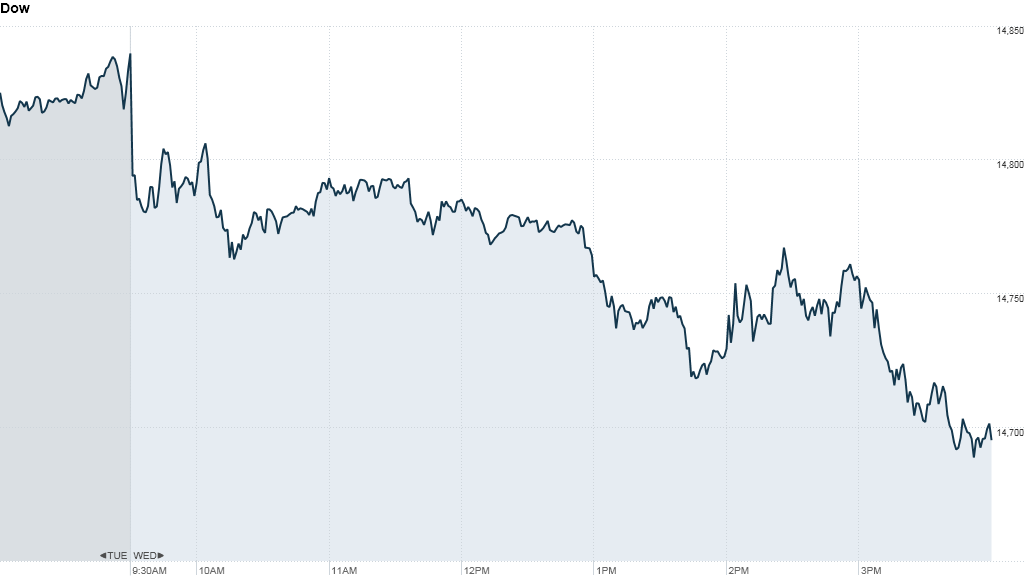With the calendar now reading May, investors are wondering if it will pay to "Sell in May and Go Away" again this year, as it has for the past three.
While it's only the first day of the month, investors have already taken a step back ... and the latest statement from the Federal Reserve didn't help matters.
The Dow Jones industrial average dropped almost 140 points, or 0.9%. The S&P 500 and Nasdaq also fell 0.9%.
"There are certain things we have gotten used to counting on each spring: the season changes and the weather warms, baseball games bring fans to the stadiums, the economy weakens, and investors 'sell in May and go away,'" said Jeffery Kleintop, chief market strategist at LPL Financial in a recent note to clients.
Click here for more on stocks, bonds, currencies and commodities
Fears of a pullback have been growing for two major reasons.
First off, recent economic reports have been signaling that a spring swoon could be just around the corner, for the fourth year in a row.
The latest jobs data have been particularly disappointing, with the March jobs report as well as Wednesday's report from payroll processor ADP signaling a sharp slowdown in hiring. That's particularly concerning ahead of the government's April jobs report due Friday. Economists expect a gain of 155,000 jobs.
Manufacturing activity and retail sales have also been slowing. Housing has been a bright spot as of late, but construction spending unexpectedly dropped almost 2% in March. And while a majority of U.S. companies have been exceeding earnings growth forecasts, they've largely been falling short of revenue growth expectations.
Then there's the additional pressure from overseas. The eurozone remains in recession and China's economy grew at a slower pace at the start the year than economists had expected.
Related: Pimco's Bill Gross gets bullish. Sorta.
Secondly, stocks have been on a tear for the past several months. The S&P 500 closed April at a record high, while Nasdaq finished at its highest level in more than 12 years. And the Dow ended just a hair below its all-time high.
Milestones can be alluring, but there's also a chance that enthusiasm can be overdone considering the still-fragile economy. And it's important to note that stocks also peaked in April in 2010, 2011 and 2012.
The one key difference between then and now is the Fed's open-ended stimulus program.
Related: Apple's new blockbuster: Bonds
Fed in focus: The Fed's policies have widely been given credit for boosting stocks. In previous years, the rally and the economy lost steam as the Fed neared the end of its bond buying programs: QE1 in 2010, QE2 in 2011 and Operation Twist in 2012.
But the current bond buying program -- $85 billion a month -- is not expected to taper off until later this year at the earliest, said Kleintop.
In fact, the Fed said Wednesday afternoon that while it is sticking to the current pace for now, it is "prepared to increase or reduce" the amount it buys in bonds each month based on the outlook for the job market and changes in inflation.
In addition to indicating that it may do more to stimulate the economy, the Fed also took a jab at Congress, highlighting that "fiscal policy is restraining economic growth."
Related: Fear & Greed Index gets greedy

Stocks to watch: Facebook (FB) stock declined in after-hours trading after the company's first-quarter earnings came in below expectations. Revenues were slightly higher than forecasts.
Shares of T-Mobile (TMUS) rose as they made their debut on the New York Stock Exchange following the merger with MetroPCS.
Apple's (AAPL) stock price edged down, a day after rising more than 3% ahead of it record $17 billion bond sale.
Humana (HUM) shares jumped after the health care company delivered a strong first-quarter profit thanks to lower benefit expenses and increased membership. Genworth Financial (GNW) shares surged after the company said that its quarterly profit more than doubled. Humana and Genworth were among the biggest winners in the S&P 500 Wednesday.



